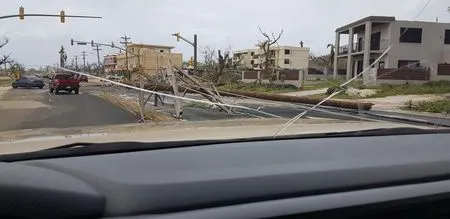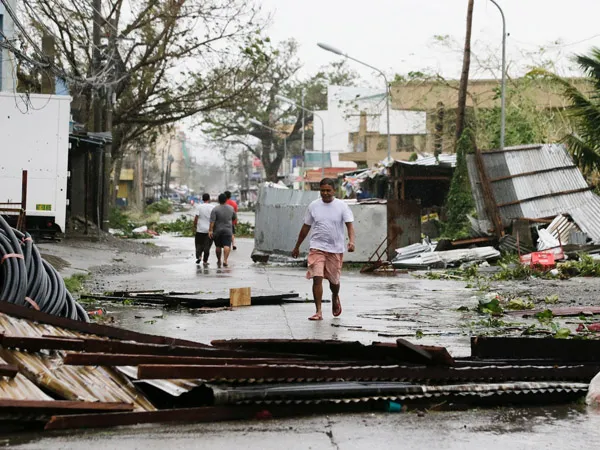Dự báo bão khi vào đất liền sẽ gây ra mưa lớn, giông gió, lũ lụt và sạt lở đất.
Bão Yutu tuần trước vừa gây thiệt hại nặng nề khi trực tiếp đổ bộ vào quần đảo Mariana phía Tây Thái Bình Dương của Mỹ, với sức gió lên đến 270km/h. Tại đây, bão đã đánh tan mái nhà, làm lật các phương tiện giao thông và điện nước cũng bị cắt. Theo Cục quản lý khí tượng thủy văn Philippines (PAGASA), bão sẽ tiến vào đất liền trong sáng thứ ba, di chuyển băng qua đảo Luzon trước khi rời Philippines trong 24 giờ tiếp theo.

Quang cảnh vùng Saipan thuộc quần đảo Mariana, Mỹ khi bị bão Yutu tàn phá ngày 25/10/2018. Ảnh: Reuters
Ghi nhận vào trưa ngày thứ hai, bão Yutu đang cách đất liền 400 km về phía đông, với sức gió đang giảm dần, dao động từ 150-170km/h.
Ba tỉnh phía bắc khu vực quần đảo Luzon gồm Isabela, Cagayan đã bắt đầu sơ tán cư dân đến các trung tâm sơ tán tạm thời trong khi tình vùng núi Cordillera được đưa vào diện cảnh báo đỏ về sạt lở đất.
Bão Yutu, với tên gọi tại Philippines là Rosita, là cơn bão thứ 18 trong năm tiến vào quốc gia này và xuất hiện sau 6 tuần kể từ khi siêu bão Mangkhut cũng đổ bộ Luzon, gây ra sạt lở đất khiến hàng chục người thiệt mạng và thiệt hại hoa màu khoảng 180 triệu USD.

Siêu bão Mangkhut đổ bộ tàn phá Philippines trong tháng 9 vừa qua. Ảnh: BBC
Các trường học ở Luzon sẽ được tạm nghỉ và ngư dân vùng biển phía đông được khuyến cáo không ra khơi vì các cột sóng có thể đánh cao tới 3m. Ngoài ra, tất cả các dịch vụ chèo thuyền tại thành phố Batangas cách thủ đô Manila 83km về phía Nam cũng sẽ tạm dừng hoạt động.
Hơn một nửa dân số của 105 triệu người Philippines sinh sống tại khu vực quần đảo Luzon. Theo thống kê, mỗi năm quốc gia này phải đón nhận trung bình 20 cơn bão.
Philippines evacuates coastal areas ahead of typhoon Yutu
(Reuters) - The Philippines raised storm warning levels on Monday and began evacuating some coastal communities in the path of a typhoon that threatened storm surges, landslides and floods triggered by heavy winds and rain.
Typhoon Yutu, which caused havoc last week with a direct hit on the U.S. Northern Mariana islands, was set to make landfall on Tuesday morning and move across the main island of Luzon before leaving the Philippines 24 hours later, the state weather agency PAGASA said.
By mid-morning on Monday, Yutu was about 400 km (249 miles)east of the mainland and had weakened to sustained wind speeds of 150 km per hour (93 mph), with gusts of 185 kph, from 170 kph recorded a few hours earlier.
That was less intense than four days ago, when as a super typhoon with wind speeds of over 270 kph barreled through the Marianas, a U.S. Western Pacific archipelago of 52,000 people, tearing off roofs, overturning vehicles and cutting off power and water.
Authorities in Isabela and Cagayan provinces started moving residents in coastal towns to evacuation centers while the mountainous Cordillera region was put on red alert for landslides.
Three provinces in north Luzon were elevated to warning signal 3 on the severity scale of 5, and 28 more put on the earliest warnings of 1 and 2, with strong winds and rains expected later on Monday.
Known locally as Rosita, the typhoon will be the 18th to hit the Philippines this year and comes six weeks after super typhoon Mangkhut tore across Luzon, triggering landslides that killed dozens of people and damaged about $180 million of crops.
School classes were suspended in at least five provinces and fishermen in Luzon and the eastern seaboard advised not to go to sea, with warnings of storm surges of up to three metres in six provinces.
All boat services in the port city of Batangas, about 83 km (52 miles) south of Manila, were suspended on Monday.
About half of the Philippines’ 105 million population live in the Luzon region. The country is hit by an average 20 typhoons each year.



